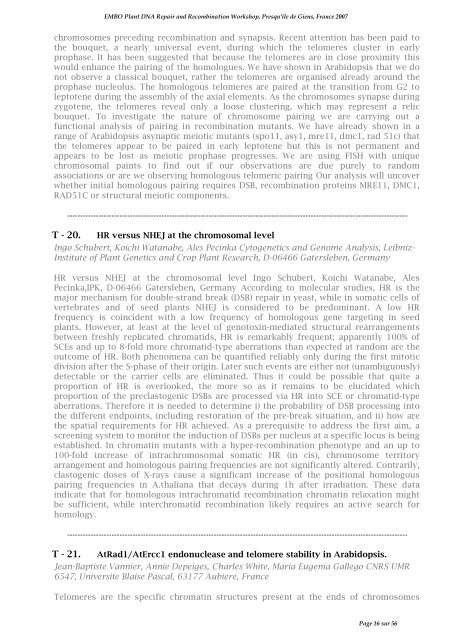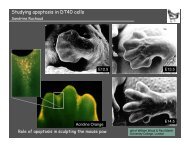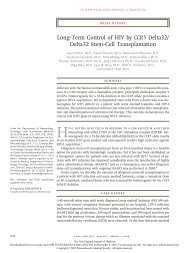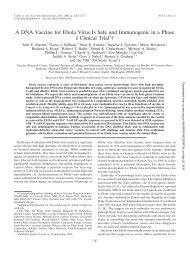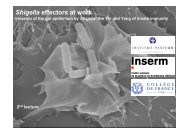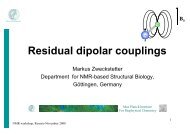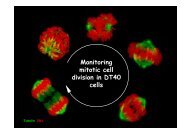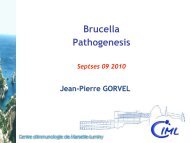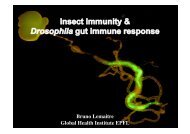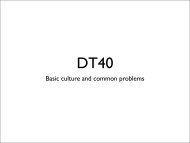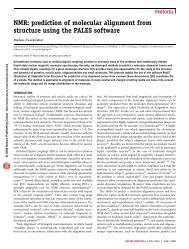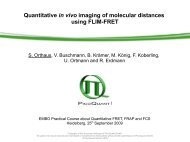pdf file - Events - EMBO
pdf file - Events - EMBO
pdf file - Events - EMBO
You also want an ePaper? Increase the reach of your titles
YUMPU automatically turns print PDFs into web optimized ePapers that Google loves.
<strong>EMBO</strong> Plant DNA Repair and Recombination Workshop, Presqu'île de Giens, France 2007<br />
chromosomes preceding recombination and synapsis. Recent attention has been paid to<br />
the bouquet, a nearly universal event, during which the telomeres cluster in early<br />
prophase. It has been suggested that because the telomeres are in close proximity this<br />
would enhance the pairing of the homologues. We have shown in Arabidopsis that we do<br />
not observe a classical bouquet, rather the telomeres are organised already around the<br />
prophase nucleolus. The homologous telomeres are paired at the transition from G2 to<br />
leptotene during the assembly of the axial elements. As the chromosomes synapse during<br />
zygotene, the telomeres reveal only a loose clustering, which may represent a relic<br />
bouquet. To investigate the nature of chromosome pairing we are carrying out a<br />
functional analysis of pairing in recombination mutants. We have already shown in a<br />
range of Arabidopsis asynaptic meiotic mutants (spo11, asy1, mre11, dmc1, rad 51c) that<br />
the telomeres appear to be paired in early leptotene but this is not permanent and<br />
appears to be lost as meiotic prophase progresses. We are using FISH with unique<br />
chromosomal paints to find out if our observations are due purely to random<br />
associations or are we observing homologous telomeric pairing Our analysis will uncover<br />
whether initial homologous pairing requires DSB, recombination proteins MRE11, DMC1,<br />
RAD51C or structural meiotic components.<br />
----------------------------------------------------------------------------------------------------------------------------------<br />
T - 20. HR versus NHEJ at the chromosomal level<br />
Ingo Schubert, Koichi Watanabe, Ales Pecinka Cytogenetics and Genome Analysis, Leibniz-<br />
Institute of Plant Genetics and Crop Plant Research, D-06466 Gatersleben, Germany<br />
HR versus NHEJ at the chromosomal level Ingo Schubert, Koichi Watanabe, Ales<br />
Pecinka,IPK, D-06466 Gatersleben, Germany According to molecular studies, HR is the<br />
major mechanism for double-strand break (DSB) repair in yeast, while in somatic cells of<br />
vertebrates and of seed plants NHEJ is considered to be predominant. A low HR<br />
frequency is coincident with a low frequency of homologous gene targeting in seed<br />
plants. However, at least at the level of genotoxin-mediated structural rearrangements<br />
between freshly replicated chromatids, HR is remarkably frequent; apparently 100% of<br />
SCEs and up to 8-fold more chromatid-type aberrations than expected at random are the<br />
outcome of HR. Both phenomena can be quantified reliably only during the first mitotic<br />
division after the S-phase of their origin. Later such events are either not (unambiguously)<br />
detectable or the carrier cells are eliminated. Thus it could be possible that quite a<br />
proportion of HR is overlooked, the more so as it remains to be elucidated which<br />
proportion of the preclastogenic DSBs are processed via HR into SCE or chromatid-type<br />
aberrations. Therefore it is needed to determine i) the probability of DSB processing into<br />
the different endpoints, including restoration of the pre-break situation, and ii) how are<br />
the spatial requirements for HR achieved. As a prerequisite to address the first aim, a<br />
screening system to monitor the induction of DSBs per nucleus at a specific locus is being<br />
established. In chromatin mutants with a hyper-recombination phenotype and an up to<br />
100-fold increase of intrachromosomal somatic HR (in cis), chromosome territory<br />
arrangement and homologous pairing frequencies are not significantly altered. Contrarily,<br />
clastogenic doses of X-rays cause a significant increase of the positional homologous<br />
pairing frequencies in A.thaliana that decays during 1h after irradiation. These data<br />
indicate that for homologous intrachromatid recombination chromatin relaxation might<br />
be sufficient, while interchromatid recombination likely requires an active search for<br />
homology.<br />
----------------------------------------------------------------------------------------------------------------------------------<br />
T - 21. AtRad1/AtErcc1 endonuclease and telomere stability in Arabidopsis.<br />
Jean-Baptiste Vannier, Annie Depeiges, Charles White, Maria Eugenia Gallego CNRS UMR<br />
6547, Universite Blaise Pascal, 63177 Aubiere, France<br />
Telomeres are the specific chromatin structures present at the ends of chromosomes<br />
Page 16 sur 56


